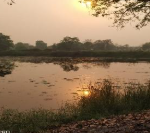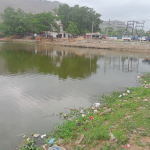1. About: A Survivor of the Seas
The Olive Ridley Sea turtle (Lepidochelys olivacea), also known as the Pacific Ridley Sea turtle, is a fascinating marine species belonging to the Cheloniidae family. It is one of the smallest yet most abundant sea turtles found across tropical oceans, including the Pacific, Indian, and Atlantic Oceans.
Despite their abundance, Olive Ridleys face critical threats. Historically, their Pacific population was estimated at around 10 million, but numbers have plummeted due to overexploitation, habitat destruction, pollution, and climate change. The primary threats include bycatch in fishing gear and the direct harvesting of turtles and eggs. The International Union for Conservation of Nature (IUCN) lists the Olive Ridley as Vulnerable, making conservation a global priority.
2. A Look at Their Unique Appearance
The Olive Ridley Sea Turtle is a small marine turtle with an olive-greyish-green body and a heart-shaped carapace (top shell). The carapace features 5 to 9 pairs of scutes (shells), which are bony external plates. Their four flippers each have one or two claws, aiding in movement and digging nests.
These turtles are sexually dimorphic—males have longer tails extending beyond their shell and claws on their front flippers, distinguishing them from females. Despite their strong bite, they lack teeth and rely on a sharp beak for feeding.
3. Mysterious Behaviors and Remarkable Journeys
Olive Ridley sea turtles are primarily solitary creatures that prefer the open ocean, migrating hundreds or even thousands of miles each year. Despite their vast travels, they exhibit strong site fidelity, returning to the same beach where they hatched to lay their eggs. This remarkable navigational ability ensures the continuation of their species.
A unique behavioral trait of this species is arribada nesting, where thousands of females gather and nest simultaneously—a phenomenon observed only in Olive Ridley and Kemp’s Ridley turtles. However, solitary nesting is also common across their range.
4. What’s on Their Menu?
Olive Ridley sea turtles are omnivores, consuming both plant and animal matter. Their diet includes algae, sea grass, jellyfish, tunicates, mollusks, snails, and fish. They are known to prey on shellfish such as shrimp, crabs, and lobsters. Equipped with powerful jaws, they can crush hard-shelled prey like mollusks and crabs. These turtles feed at depths of up to 500 feet (150 meters), searching for invertebrates.

5. Home Across the Oceans
Olive Ridley sea turtles inhabit both pelagic (open ocean) and coastal waters across tropical regions. They are commonly found in the Indian Ocean, from the Gujarat coast to Odisha, Bengal, Andaman, and Lakshadweep, and travel from Australia to India. In the Atlantic, they occur along the coasts of West Africa and South America, while in the Eastern Pacific, they range from Southern California to Northern Chile.
6. Reproduction: The Spectacle of Arribada
One of the most remarkable reproductive behaviors of the Olive Ridley turtle is the phenomenon known as “arribada,” a Spanish term meaning “arrival.” During an arribada, thousands of female turtles return to the beaches where they were born to lay eggs. This synchronized mass nesting is unique to Ridley turtles and occurs only at select locations worldwide.
7. How Long Do They Live?
The Olive Ridley Sea turtle is a long-lived marine species, with individuals capable of surviving up to 50 years in the wild. These turtles reach sexual maturity between 10 and 18 years of age, with some estimates suggesting a more precise range of 13 to 15 years.
8. Migration: A Never-Ending Voyage
Olive Ridley sea turtles migrate thousands of kilometers annually between feeding and nesting grounds. Unlike other species, their migrations do not follow specific paths but involve dispersion to different areas. Around September, they travel from the Pacific Ocean to the Indian seas.
9. Incredible Adaptations for Survival
- Their smooth, streamlined head and carapace reduce drag, making swimming more energy-efficient.
- Being cold-blooded allows them to adjust to varying water temperatures within limits.
- Can dive for extended periods in warm water.
- Can hold their breath for several hours, depending on their activity level.
- Their hard shell provides armor against predators.
- Long, stiff fore flippers help them propel efficiently through the water.
- Large eyes enable them to see in the dim light of deep waters.
- They have a high lung capacity, allowing a large exchange of oxygen per breath.
- They have strong jaws adapted for crushing prey such as crustaceans and mollusks.
- Females exhibit mass nesting (arribada), increasing their offspring’s survival by overwhelming predators with sheer numbers.
10. The Many Dangers They Face
After 45-65 days, Olive Ridley hatchlings emerge and face numerous predators. On land, jackals, birds, hyenas, fiddler crabs, and feral dogs prey on them during their journey to the ocean. In the water, hatchlings fall victim to oceanic fish, sharks, and crocodiles. Human activities, including bycatch in fishing gear and egg harvesting, pose significant threats, further reducing their population.
11. A Call for Conservation!
The Olive Ridley Sea turtle faces severe threats, endangering its survival. Conservation efforts are crucial to protecting them from these challenges:
- Protected Nesting Sites – Conservation areas established in India, Costa Rica, and Mexico.
- Turtle Excluder Devices (TEDs) – Reducing accidental turtle capture in fishing operations.
- Community Involvement – NGOs and local groups aiding conservation efforts.
- Legal Protections – Laws like India’s Wildlife Protection Act (1972) and CITES banning trade in turtles and eggs.
- Beach Clean-ups & Awareness – Reducing marine plastic waste and educating locals.
- Climate Adaptation Strategies – Adjusting nesting environments to maintain balanced hatchling sex ratios.
The remarkable Olive Ridley Sea Turtle continues to navigate the world’s oceans, facing both natural and human-induced challenges. Conservation efforts and awareness initiatives remain critical in ensuring that these ancient mariners thrive for generations to come!








